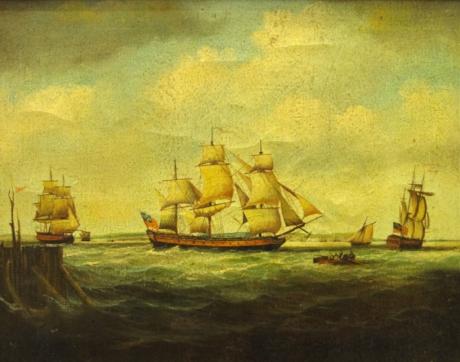A frigate is any of several types of warship, the term having been used for ships of various sizes and roles over the last few centuries. In the 17th century, the term was used for any warship built for speed and maneuverability, the description often used being "frigate-built". These could be warships carrying their principal battery of carriage-mounted guns on a single deck or on two decks (with further smaller carriage-mounted guns usually carried on the forecastle and quarterdeck of the vessel). The term was generally used for ships too small to stand in the line of battle, although early line-of-battle ships were frequently referred to as frigates when they were built for speed. In the 18th century, the term referred to ships which were usually as long as a ship-of-the-line and were square-rigged on all three masts (full rigged), but were faster and with lighter armament, used for patrolling and escort. In the definition adopted by the British Admiralty, they were rated ships of at least 28 guns, carrying their principal armament upon a single continuous deck—the upper deck, while ships-of-the-line possessed two or more continuous decks bearing batteries of guns. Frigates did not carry any guns (or have any gunports) on their lower decks; confusingly, the lower deck was often referred to as the "gun deck" in the British Royal Navy (in the United States Navy, it was usually called the "berth deck"), even for frigates, where it did not carry any guns or have gunports. Both types could (and usually did) additionally carry smaller carriage-mounted guns on their quarter decks and forecastles (the superstructures above the upper deck). Technically, rated ships with fewer than 28 guns could not be classed as frigates but as "post ships"; however, in common parlance most post ships were often described as "frigates", the same casual misuse of the term being extended to smaller two-decked ships that were too small to stand in the line of battle. In the late 19th century (beginning about 1858 with the construction of prototypes by the British and French navies), the armoured frigate was a type of ironclad warship and for a time was the most powerful type of vessel afloat. The term "frigate" was used because such ships still mounted their principal armament on a single continuous upper deck. The later 19th century battleship thus developed from the frigate rather than from the ship of the line.
English
School 19th
Century
A Frigate in Three Positions off the Downs on the English Coast
A Frigate in Three Positions off the Downs
oil on canvas
33 x 44 cm. (13 x 17.1/2in.)
£1200
Notes

